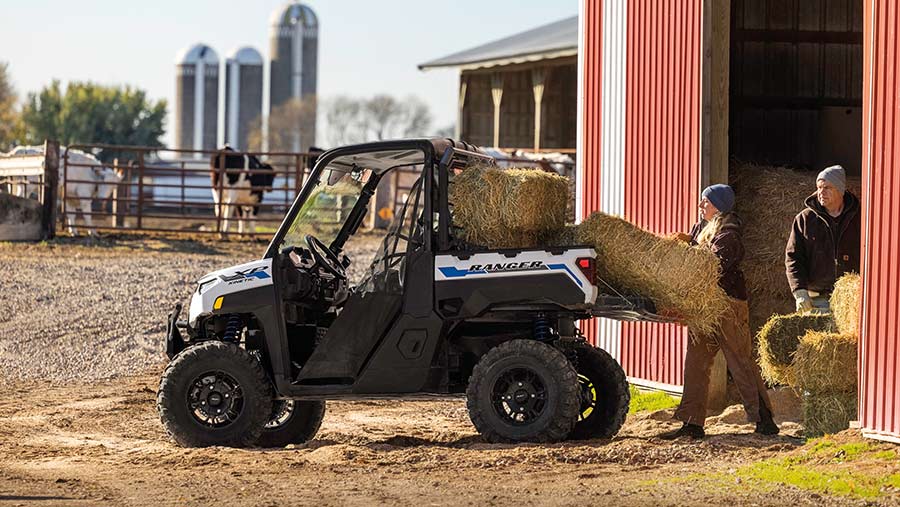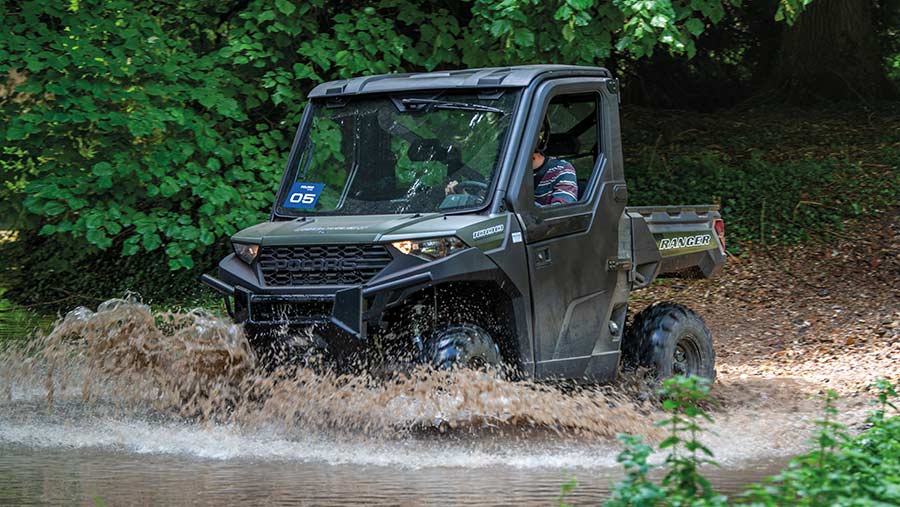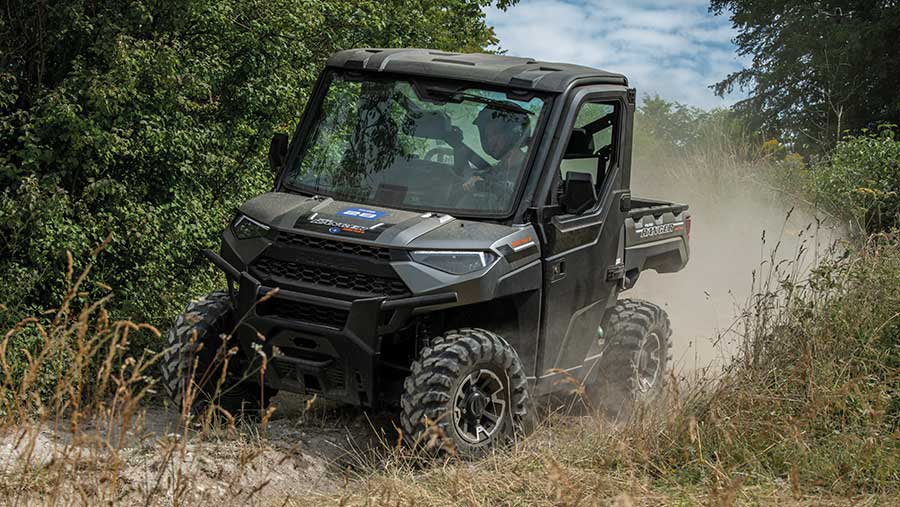Electric XP Kinetic to be most powerful Polaris Ranger UTV
 © Polaris
© Polaris The electric XP Kinetic Ranger is on course to be the most powerful model in the Polaris UTV range, but flaky battery supplies have held up its UK launch.
It will offer more than triple the output of the firm’s existing EV model, with the powertrain – developed in partnership with Californian firm Zero Motorcycles – producing a potent 110hp (82kW) and 190Nm of instant torque. That puts it well above the Suzuki Jimny and edges it closer to pickup territory than ever before.
Polaris has reported surging demand for its current EV, despite it remaining largely unchanged for eight years. That’s thanks to the appeal of whisper-quiet operation, the availability of grant funding and, for those with a means of generating renewable electricity on site, the potential for free fuel.
See also: Polaris adds electric Ranger XP Kinetic UTV to its ranks
However, the EV uses fairly archaic lead-acid battery technology and, as such, has an estimated range of 35 miles. In comparison, the Premium-spec Kinetic’s single 14.9kWh lithium-ion battery is reckoned to offer 45 miles, and spending an extra £5,800 will bag you the Ultimate variant, which has the same power but double the battery capacity, at 29.8kWh, to provide a claimed 80-mile range.
The Kinetic is also rated to carry and tow far more because it’s based on a full-size, rather than the EV’s mid-size, chassis. So, while the EV was good for a 454kg payload, 227kg in the cargo box and 680kg on the tow hook, the XP Kinetic ups those to a class-leading 680kg, 567kg and 1,134kg.
Ground clearance has risen to 355mm and there’s 254mm of suspension travel, so it should be able to handle the worst a Welsh hillside has to offer when shod with 74cm eight-ply Pro Armor X-Terrain tyres.
Electric advantages
Polaris says that the biggest perk of going electric is the reduction in moving parts compared with a combustion engine, as there are no oil changes, filter replacements, spark plugs or clutches to worry about.
Maintenance costs are said to be 70% lower than a machine with an engine, although owners will have to enlist a dealer to take care of the servicing.
These savings will go some way to clawing back the higher up-front cost, with the Premium model listing at £23,399 and the Ultimate at £29,199 – the latter more than £10,000 above the pokiest petrol models Polaris offers.

© Polaris
To soften the blow, the company offers a one-year warranty on the whole machine, plus three years for the electric powertrain and five for the batteries.
Cab features include three seats and an 18cm infotainment screen that, among other things, shows the remaining range. There’s also a different range shifter, with high, low, neutral and park on the stick, and a new integrated switch to flick between forward and reverse. And there are three driving modes – eco+, standard and sport – that vary the throttle response and alter performance, to the benefit or detriment of the battery range.
The standard on-board chargers are rated to 3kW for the Premium trim and 6kW for the Ultimate, meaning both will take five hours from flat to full. There’s also the option of upgrading to 6kW and 9kW charging kits, respectively, which are 50% quicker.
The plugs can be connected to a 120V or 240V outlet, with the latter up to four times faster.
As with the rest of the Polaris range, there is a stack of extras to pick from. The Kinetic is compatible with 95% of the Ranger XP 1000’s accessories, including the Pro Shield cab, winches and cargo storage kits.
It can also have a 12V cargo box outlet for powering sprayers or charging portable batteries, and a fast-acting electric heater kit.
Ranger UTV upgrades
Polaris has added new upgrades and colour options to its regular Ranger UTVs and Sportsman ATVs.
The Ranger Diesel and Diesel Deluxe have updated rubber mountings to isolate the front drive vibration from the chassis and passengers, and a 15% stronger chassis. There’s also a new handbrake handle, wing mirrors, the option of Pro Armor X-Terrain 27in tyres, and a “super graphite” alternative to the “sage green” body colour on the Diesel Deluxe variant.
This model, which was launched last year, adds extra sound deadening, a pre-fitted heater, alloy wheels and more storage under upgraded seats – for £2,200 above the standard Diesel model.
Power comes from the same 24hp Kubota engine, with improvements to the latest generation seeing the service interval doubled to 200 hours, and better wheel bearings, bushes and track rods. As a result, Polaris’s warranty costs have plummeted, and some are doing up to 25,000 miles annually, says the firm’s Richard Coleby.
He reckons the CVT belt should manage 1,000 hours before replacement, unless it has been subjected to plenty of towing or hill work, or if the low range isn’t used correctly. This runs behind the same Team Industries clutch used on the John Deere Gator.
As before, the two-range transmission can be run in Versatrak mode, which opens the rear differential to effectively make it single-wheel drive, and on-demand four-wheel drive sees the front and rear diffs locked when speed sensors on the wheels detect a difference between the front and rear. Active descent control also forces the 4×4 system to engage, so engine braking is applied to all four wheels.
Other highlights include a load bed rated to 435kg, a 1,134kg towing capacity, and a top speed of 40mph.

© Polaris
Options
Standard kit includes an ATVtrac tracker with a year’s subscription and an identification badge that allows dealers to view machine, ownership and servicing details.
The most popular of Polaris’s raft of accessory options are a front bumper, winch and rear bed extension. Air-conditioning isn’t currently available on cabbed models, although it is offered in North America on top-spec versions.
According to Polaris UK, demand is beginning to shift towards petrol power, which currently accounts for 35% of sales. This has been driven by the rising cost of red diesel, and the fact that petrol engines have been more readily available, with Kubota having reduced its diesel engine production during Covid.
The second-hand market is also buoyant, with prices up 60% in just a couple of years. For those buyers clocking up high hours and chopping in their machines every two years, it has reduced the replacement cost from £10,000 to £6,000, says Mr Coleby, so the cost of ownership is much lower – despite new prices rising 22% over that period.
A Ranger Diesel costs £15,599 and the Deluxe is £18,399.

